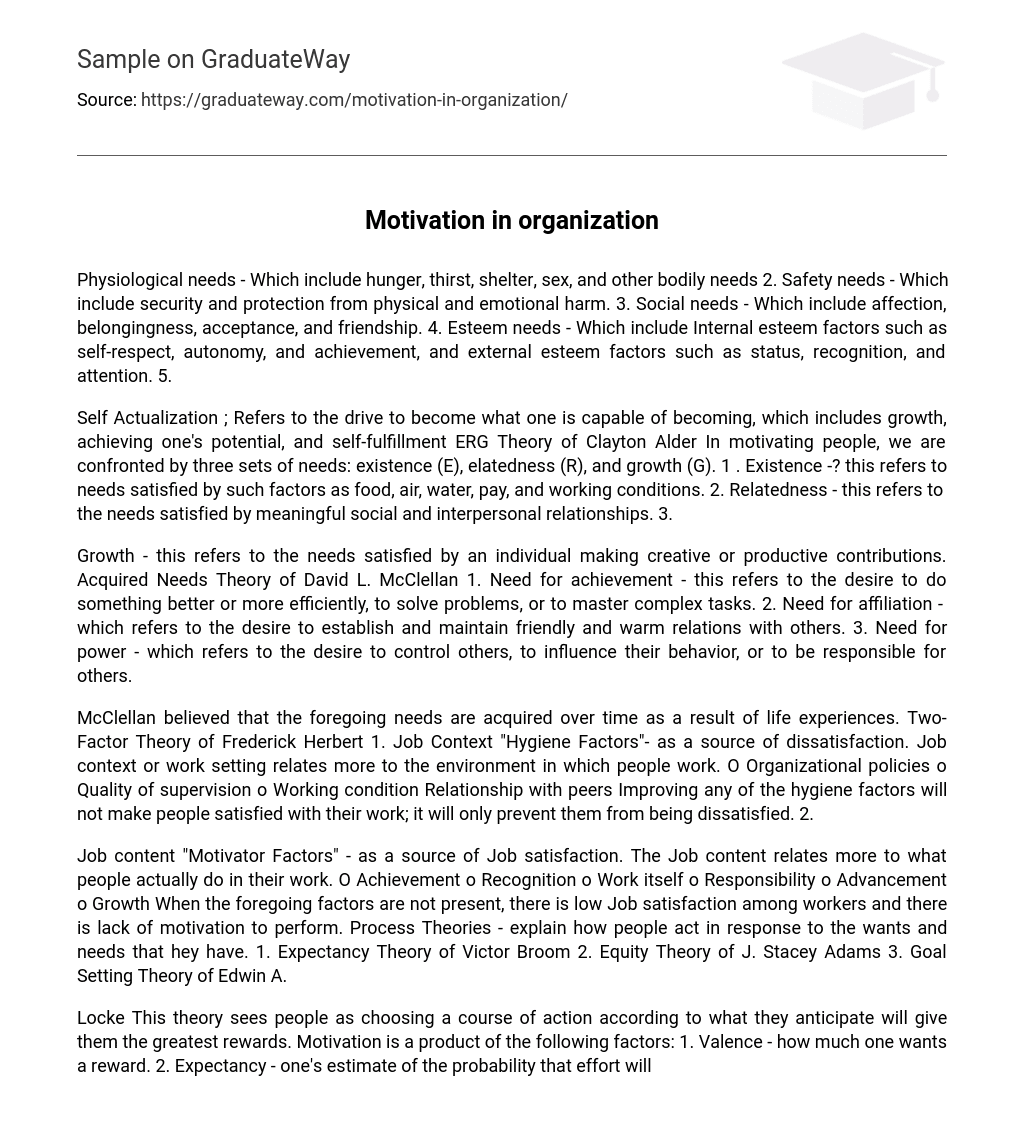Physiological needs, such as hunger, thirst, shelter, sex, and other bodily needs, are the basic bodily requirements. Safety needs encompass the need for security and protection from physical and emotional harm. Social needs involve the desire for affection, belongingness, acceptance, and friendship. Esteem needs consist of both internal factors like self-respect, autonomy, and achievement, as well as external factors like status recognition and attention.
The idea of self-actualization entails the longing to achieve one’s utmost potential and undergo individual growth and satisfaction. This notion is incorporated in Clayton Alder’s ERG theory, which delineates three categories of needs: existence, relatedness, and growth. The initial category, existence, encompasses fundamental necessities like food, air, water, pay, and working conditions. The second category, relatedness, pertains to the yearning for significant social and interpersonal connections. Lastly, the third category, growth, involves the aspiration for personal development and progression.
Growth refers to the needs satisfied by an individual making creative or productive contributions. The Acquired Needs Theory by David L. McClellan identifies three main needs: the need for achievement, the need for affiliation, and the need for power.
The need for achievement is the desire to improve or more efficiently accomplish tasks, solve problems, or master complex tasks.
The need for affiliation is the desire to establish and maintain friendly and warm relationships with others.
The need for power is the desire to control others, influence their behavior, or be responsible for others.
McClellan believed that the aforementioned needs are obtained gradually through life experiences. Frederick Herbert’s Two-Factor Theory categorizes job context, also known as work setting, as “Hygiene Factors” that cause dissatisfaction. Job context includes organizational policies, quality of supervision, working conditions, and relationships with peers. Enhancing any of these hygiene factors will not lead to job satisfaction, but it will prevent dissatisfaction.
Job content, also known as “Motivator Factors,” plays a crucial role in determining job satisfaction. It involves the actual tasks and responsibilities that individuals perform in their work. Key motivator factors include achievement, recognition, the work itself, responsibility, advancement, and growth. When these factors are missing, job satisfaction decreases, and employees become less motivated to perform their tasks.
Process Theories, on the other hand, aim to explain how people respond to their wants and needs. There are three main process theories:
- Victor Broom’s Expectancy Theory
- J. Stacey Adams’ Equity Theory
- Edwin A.’s Goal Setting Theory
Locke’s theory suggests that individuals’ choices depend on their belief in the rewards they will receive. Motivation is influenced by three factors: valence, which represents the desire for a reward; expectancy, which gauges the likelihood of success through effort; and instrumentality, which entails the belief that performance leads to receiving the reward. Expectancy theory states that high motivation arises when all three factors are rated positively. Conversely, low motivation is anticipated if any or all of these factors are rated negatively.
The Equity Theory, developed by J. Stacey Adams, is a theory that focuses on individuals comparing their job inputs and outcomes with those of others in order to address any unfairness. This theory operates under the assumption that employees are driven by the desire for fair treatment at work. Fairness is achieved when employees perceive that the ratios between their efforts (inputs) and rewards (outputs) are comparable to those of their colleagues. Conversely, unfairness occurs when these ratios differ.
Another theory associated with workplace motivation is Edwin A.’s Goal Setting Theory.
According to Locke’s theory, improved performance can be achieved through specific and challenging goals along with feedback. A goal is a target that an individual aims to achieve. The theory suggests the following:
1. Specific goals result in higher performance compared to general goals.
2. Performance increases as the difficulty of the goal increases. Challenging goals test one’s ability, but excessively difficult goals may lead to frustration instead of motivation.
3. Employees must accept and embrace the goals set by their superiors for performance improvement.





